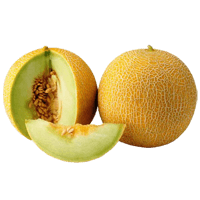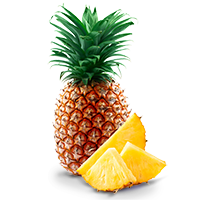Watermelon nutrition: glycemic index, calories, net carbs, diets
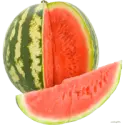
Introduction
Watermelon has become a symbol of summer in numerous cultures. It is refreshing and bright and consists of more than ninety percent water, hence the name.
We will talk about the part of the watermelon that isn’t water, how it affects our health, and how it fits into different diets. In other words, we are here to tell you everything you want to know about watermelon.
Classification and Varieties
In its botanical classification, watermelon is called a pepo: a modified berry with a thick and hard outer rind. It is loosely considered a melon; however, it is not in the Cucumis genus of melons. Instead, it is in the same Cucurbitaceae family as melons, cucumbers, and pumpkins.
The stripes of a watermelon indicate its variety. There are over 1200 watermelon varieties; however, the most popular ones are the seeded, seedless, mini, or yellow and orange watermelons.
History
The origin of watermelon is disputable. Scientists agree that watermelon’s progenitor was cultivated in the continent of Africa. The debate starts with the question of where exactly.
5000-year-old remnants of watermelon seeds were found in Libya. In Egyptian tombs, there were not only 4,000-year-old seeds but also paintings of watermelons. Centuries later, it spread and found popularity in Mediterranean countries (1).
Nutrition
Every part of the watermelon is technically edible; thus, it is considered a zero-waste food. Watermelon seeds and the rind naturally have different nutrition values than red flesh. The seeds are often roasted, and the rind can be used as a vegetable, stewed, fried, or pickled.
Some recommend incorporating watermelon seeds in traditional recipes, especially in areas where chronic hunger is an issue, as it is usually locally available and thrown away, to improve the intake of protein, fat, calcium, carbohydrates, and phosphorus (2).
Macronutrients and Calories
Around 92% of a watermelon’s weight is water; only 8% consists of nutrients.
One average serving size of watermelon per person is one slice or 280g.
A 100g of watermelon contains only 30 calories, while one average serving contains 84.
Macronutrients chart
What Do 30 Calories or 100 Grams of Watermelon Look Like?
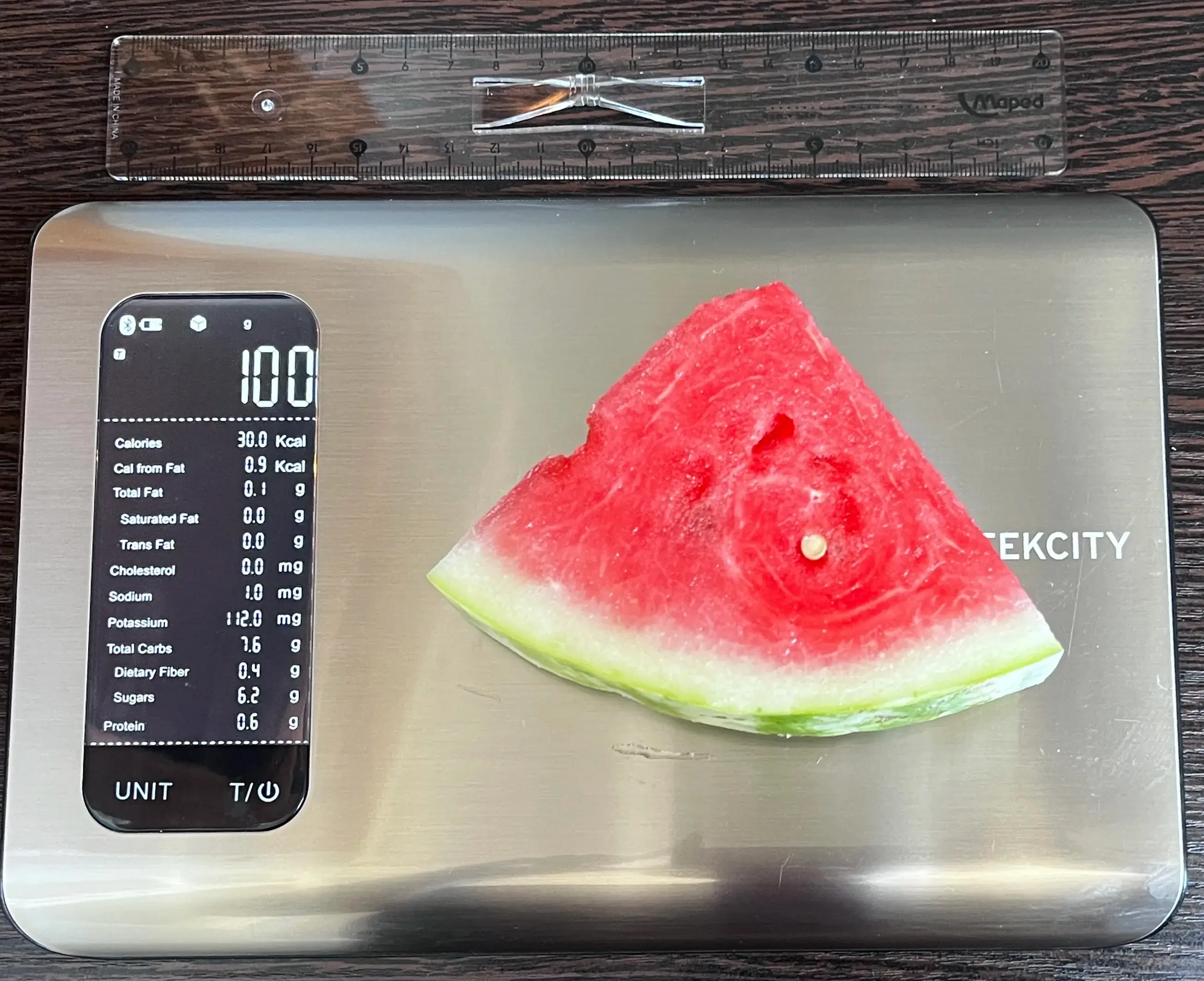
100 grams of watermelon contains 30 calories. This refreshing fruit is mostly water, making it extremely low in calories while providing natural sugars, vitamins, and antioxidants.
A typical serving of watermelon is around 280 grams, which amounts to 84 calories. Its high water content and natural sweetness make it a satisfying and hydrating snack.
Carbohydrates
The predominant macronutrients in watermelon are carbohydrates. Of the 8% nutrients of watermelon, 7.55g consists of carbohydrates.
The watermelon pulp is very low in fiber, containing only 0.95g. The other 7.15g are composed of net carbs.
One average serving size of watermelon provides 20g of net carbs.
The net carb content contains mainly sugars, such as fructose, glucose, sucrose, and only a small amount of maltose.
Carbohydrate type breakdown
Protein and Fats
The protein concentration is deficient, with only 0.6g in 100g of watermelon. It also has an insignificant amount of fats; therefore, it is low in saturated fats and has no trans fats or cholesterol.
In protein quality breakdown, out of all the essential amino acids, tryptophan, threonine, and lysine are contained in equal amounts and have the highest concentration. The remaining essential amino acids are equal, but each makes up only 1% of the protein.
Seeds and Rind
Watermelon seeds have a lot more protein (around 8%) and fats (around 17%), as well as fiber (around 40%) and calories; however, it is much more challenging to consume 100g of watermelon seeds (3).
Another study about the nutritional values of watermelon seeds found very different numbers, putting protein at around 34%, 32% fat, 27% carbohydrates, and 0.1% dietary fiber (4).
The watermelon rind is rich in a non-essential amino acid called citrulline, also found in the flesh. Red flesh watermelon has slightly less citrulline than yellow and orange flesh watermelons (5).
Vitamins
Watermelon is an excellent source of vitamin A and vitamin C. It falls in the top 26% of foods as a source of these vitamins.
It also contains low to moderate amounts of B complex vitamins, particularly B1, B2, B3, B5, and B6. It is low in vitamin K and vitamin E.
Watermelons are absent in vitamin D, vitamin B12, and vitamin B9.
Watermelon seeds are rich in vitamin E and vitamin C (4). They are also much higher in vitamin B3 than flesh (6).
The rind of a watermelon is richer in vitamin A and contains high amounts of vitamin C (6).
Vitamin coverage chart
Minerals
Watermelon alone is not a great source of minerals. However, watermelon pulp is relatively high in potassium, manganese, magnesium, calcium, and phosphorus.
It has moderate amounts of copper, iron, zinc, selenium, and choline. It is deficient in sodium.
Watermelon seeds also contain appreciable minerals: calcium, phosphorus, magnesium, sodium, potassium, and zinc (3).
Mineral coverage chart
Glycemic Index (GI)
Based on the numbers from The International Tables of Glycemic Index, the glycemic index of a raw watermelon from Australia containing 10g of carbohydrates is 80±3. In parallel with that, a raw watermelon containing 25g of carbohydrates has a GI of 72±13. The difference in carbohydrate concentration is based on the season and the growing environment.
Based on these numbers, the average GI of watermelon is 76 (7).
Despite the high GI, watermelon’s glycemic load of 4-6 is low, meaning one serving of watermelon contains only 6g of carbohydrates.
According to Harvard Health Publishing, a raw watermelon has a GI of 76±4 (8).
Another study has shown different numbers for the GI of a watermelon. They found red-fleshed seedless watermelon to have a GI of 51±2. Red-fleshed seeded watermelon has a slightly lower GI of 48±1, with yellow-fleshed watermelon having an even lower GI of 47±2. This study has shown no difference between the GI of a red-fleshed seedless watermelon and the juice extracted from it. (9)
Other research has shown that watermelon from the Philippines has a GI of 48±4 and Malaysian watermelon has a GI of 55±3 (10, 11).
A watermelon’s glycemic index can be high or low, depending on the maturity stage, fiber and fat content, processing and treatment of the sample, and other factors.
Despite all these positive effects, people with diabetes are advised to moderate watermelon intake and combine high-sugar fruits with healthy fats, fiber, and proteins to slow glucose absorption into the bloodstream.
You can find GI values for other foods by visiting our glycemic index chart page.
Oxalates
Oxalates are famous antinutrients in fruits and vegetables that may bind to calcium ions in organisms and result in kidney stones. Watermelon oxalate content is negligible: it contains 0mg of oxalates per serving size (29). However, watermelon seeds contain approximately 0.5g per 100g (30).
FODMAPs
FODMAPs are nutrients, especially carbohydrates, that may trigger irritable bowel syndrome. Fructose is such a nutrient contained in watermelon. There is 3.36g of fructose per 100g of watermelon. Hence, people intolerant to FODMAPs should avoid watermelon consumption; otherwise, it may result in gas, stomach ache, bloating, and diarrhea.
Phytochemicals
Watermelon is rich in different types of phytochemicals, such as antioxidant vitamin C, flavonoids, phenolics, etc. However, carotenoids like lycopene and beta-carotene are present in the highest quantities.
Lycopene is a natural antioxidant that fights oxidative stress, cancer, diabetes, and other conditions (31). Fresh watermelon contains approximately 7.2mg of it per 100g.
Beta-carotene is a carotenoid, an antioxidant that helps prevent oxidative damage, cognitive decline, and cancer formation. Red watermelon provides 4.42mg of it per 100g (32).
Health Impact
Diabetes
Watermelons have an average glycemic index of 76, but that number can change depending on the maturity and carbohydrate composition of the watermelon.
Watermelons get their bright color from a carotenoid called lycopene. This compound has gained attention from scientists due to its bioavailability and high absorption levels in a watermelon. It has been proven to positively affect the cardiovascular system while also playing a role in defending the organism from diseases such as diabetes and cancer (12).
Another essential component of a watermelon is the non-essential amino acid called L-citrulline, which has been studied as a potential non-pharmaceutical treatment for insulin resistance (13). L-citrulline is contained in incredibly high concentrations in the rind of a watermelon.
Once again, the consumption of watermelon is advised alongside healthy fats, fiber, and protein, such as nuts, for people with diabetic conditions to slow the absorption of glucose.
Cardiovascular
The amino acid L-citrulline can protect the organism not only from diabetes but can also have a positive therapeutic effect on people with high blood pressure or other cardiovascular diseases (13).
A study has shown that it can effectively reduce the extent of cardiovascular disorders (12).
Allergy
Watermelon allergies are rare but can still occur in children and adults.
Three major allergens have been described in watermelons: malate dehydrogenase, triosephosphate isomerase, and profilin. Among watermelon-allergic patients, the frequencies of sensitization to these compounds are 96, 78, and 56 percent respectively (14).
These allergens usually cause oral allergy syndrome as the primary manifestation. It commonly presents with immediate swelling and an itching sensation in the mouth after consuming the food allergen (15).
The protein profilin can also be found in other fruits, such as melons and oranges․
Cancer
As stated, the carotenoid lycopene can also have anti-carcinogenic qualities (12).
A group of compounds in which the watermelon rind is also rich in polysaccharides, such as arabinogalactan, galactose, arabinose, rhamnose, and others. These polysaccharides are known for their antiproliferative and antioxidant properties. The antitumor activity of watermelon rind has a significant cytotoxic ability against laryngeal carcinomatous cells (16).
Watermelon rind is also rich in anthocyanin and flavonoids, known for their antioxidant, anti-inflammatory, and anticancer qualities (17).
Pregnancy
The antioxidant lycopene has also been proven to potentially reduce the development of pre-eclampsia and intrauterine growth retardation in first-time pregnant women (18).
Watermelon can be advised to patients with hyperemesis gravidarum, a pregnancy complication characterized by severe nausea and vomiting, as the high water content can help stay hydrated (19).
Urinary System
Watermelon pulp is known to have protective properties in chronic kidney failure and the potential ability to clear urine. It has been proven to possess significant anti-urolithic and diuretic activities to help people with bladder or urinary tract issues (20).
Watermelon Diet
As the name suggests, a watermelon diet is one during which you only eat watermelon. The high water content in watermelon makes this more of a cleanse than a diet.
Daily consumption of watermelon can reduce body weight, body mass index, and blood pressure, as well as improve some factors associated with obesity and being overweight. The mechanism for this action is watermelon’s ability to increase perceived satiety and moderate postprandial glucose and insulin response (21).
As a fruit, watermelon has a high density of water with low caloric intake, making it a perfect snack for people trying to lose weight. We’ve already talked about the health benefits of watermelon consumption; however, the watermelon diet is a radical form of dieting. Due to the lack of protein, fats cannot be recommended to children, pregnant women, and people with diabetes or malnourishment.
Watermelon in Diets
| Keto | The keto diet allows an average of 10-20% of your daily caloric intake to be carbohydrates (22). A 100g watermelon contains only 8g of carbohydrates; therefore, watermelons can be consumed during a keto diet with careful management of the carbohydrate intake. |
| DASH | Watermelons are suitable for the DASH diet due to their low sodium and high potassium, magnesium, and fiber concentrations. You can have 4-5 servings of fruits each day (23). |
| Atkins | You can have watermelon if you’re on the third or fourth phases of the Atkins 20 diet or the Atkins 40 diet. However, a cup of watermelon contains 11g of carbohydrates, so you have to eat it in moderation (24). |
| Mediterranean | The Mediterranean diet emphasizes using fruits and vegetables in your eating plan. Watermelon suits this diet perfectly. The Mediterranean watermelon salad is a well-known recipe. |
| Paleo | Even though prehistoric people probably did not eat watermelons, a moderate amount can be acceptable during a paleo diet. It is one of the few sweet fruits that can be used on a paleo diet (25). |
| Vegan/ Vegetarian/ Pescetarian | Since watermelons are plant species, you can naturally eat them on these diets. |
| Dukan | You cannot eat watermelons or fruits in general during the Attack and Cruise phases. You can add watermelon into your diet during the Consolidation phase, but only one serving a day. You can have moderate amounts of watermelon throughout the Stabilization phase (26). Watermelon overall is considered to be a Dukan-friendly food, depending on the phase you’re in (27). |
| Intermittent Fasting | Traditionally you should abstain from watermelon during the fasting period and eat it during the eating periods. However, some believe you can occasionally break the fast with a low-calorie seasonal fruit, like watermelon. |
| Low Fat & Low Calorie | Watermelon has almost no fat and since over 90 percent of it is water, it is one of the best fruits to eat during a low-fat or a low-calorie diet. A 100g serving of watermelon has only 30 calories. |
| Low Carb | Watermelon can be a great option to satisfy your sweet cravings during a low-carb diet, but only in moderation. Keep in mind an average serving of watermelon contains 20g of net carbs. |
| Anti Inflammatory | Watermelon is great for an anti-inflammatory diet due to its properties gained from lycopene, anthocyanin, and flavonoids (12, 17). |
| BRAT | If you are following the BRAT diet for a limited amount of time, you can add watermelon as bland food since it is an excellent source of hydration. However, you have to moderate your intake as large amounts of lycopene consumption can cause diarrhea (28). |
References
- The 5,000-Year Secret History of the Watermelon
- https://pdfs.semanticscholar.org/461c/4889b0ab6f8a34856e50aeac0a3f74d77af7.pdf
- https://www.researchgate.net/publication/323663320
- http://www.phytojournal.com/archives/2015/vol3issue6/PartB/3-6-24.1.pdf
- https://www.researchgate.net/publication/7736564
- https://www.researchgate.net/publication/259176510
- https://care.diabetesjournals.org/content/diacare/suppl/2008/09/18/dc08-1239.DC1/TableA1_1.pdf
- Glycemic index for 60+ foods
- http://www.ifrj.upm.edu.my/25%20(06)%202018/(41).pdf
- https://www.academia.edu/17584643/
- https://www.researchgate.net/publication/5488788
- https://www.ncbi.nlm.nih.gov/pmc/articles/PMC4464475/
- https://www.ncbi.nlm.nih.gov/pmc/articles/PMC6073798/
- https://pubmed.ncbi.nlm.nih.gov/19295232/
- https://www.researchgate.net/publication/289039646
- https://www.researchgate.net/publication/333828166
- https://www.scientific.net/MSF.998.261
- https://pubmed.ncbi.nlm.nih.gov/12767566/
- https://pubmed.ncbi.nlm.nih.gov/33986063/
- https://pubmed.ncbi.nlm.nih.gov/29145146/
- https://www.ncbi.nlm.nih.gov/pmc/articles/PMC6470521/
- https://www.hsph.harvard.edu/nutritionsource/healthy-weight/diet-reviews/ketogenic-diet/
- https://hypertensioninstitute.com/service/dash-1-2-diet/
- https://www.atkins.com/how-it-works/library/articles/national-watermelon-day
- https://paleogrubs.com/healthiest-paleo-diet-foods
- https://www.dukandiet.com/low-carb-diet/4-phases
- https://www.dukandiet.com/newsletter/june-2013
- https://www.cancer.gov/about-cancer/treatment/cam/patient/prostate-supplements-pdq
- https://www.sciencedirect.com/science/article/abs/pii/S0889157513000902
- http://medcraveonline.com/MOJFPT/MOJFPT-06-00170.pdf
- https://www.ncbi.nlm.nih.gov/pmc/articles/PMC4464475/
- https://www.researchgate.net/publication/276493359_Studies_on_carotenoids_in_watermelon_flesh
Top nutrition facts for Watermelon

| Calories ⓘ Calories for selected serving | 30 kcal |
|
Glycemic index ⓘ
Source:
Check out our Glycemic index chart page for the full list.
|
76 (high) |
| Glycemic load | 15 (medium) |
| Insulin index ⓘ https://synapse.koreamed.org/articles/1043926 – II for watermelon (S. Korea) is 45 | 84 |
| Net Carbs ⓘ Net Carbs = Total Carbohydrates – Fiber – Sugar Alcohols | 7 grams |
| Default serving size ⓘ Serving sizes are mostly taken from FDA's Reference Amounts Customarily Consumed (RACCs) | 1 NLEA serving (280 grams) |
| Acidity (Based on PRAL) ⓘ PRAL (Potential renal acid load) is calculated using a formula. On the PRAL scale the higher the positive value, the more is the acidifying effect on the body. The lower the negative value, the higher the alkalinity of the food. 0 is neutral. | -2 (alkaline) |
| Oxalates ⓘ https://www.sciencedirect.com/science/article/abs/pii/S0889157513000902 | 0 mg |
Watermelon calories (kcal)
| Calories for different serving sizes of watermelon | Calories | Weight |
|---|---|---|
| Calories in 100 grams | 30 | |
| Calories in 10 watermelon balls | 37 | 122 g |
| Calories in 1 cup, diced | 46 | 152 g |
| Calories in 1 cup, balls | 46 | 154 g |
| Calories in 1 NLEA serving | 84 | 280 g |
Watermelon Glycemic index (GI)
Watermelon Glycemic load (GL)
Mineral chart - relative view
Vitamin chart - relative view
Protein quality breakdown
Fat type information
Fiber content ratio for Watermelon
All nutrients for Watermelon per 100g
| Nutrient | Value | DV% | In TOP % of foods | Comparison |
| Vitamin A | 28µg | 3% | 40% | |
| Calories | 30kcal | 2% | 94% |
1.6 times less than Orange
|
| Protein | 0.61g | 1% | 89% |
4.6 times less than Broccoli
|
| Fats | 0.15g | 0% | 90% |
222.1 times less than Cheese
|
| Vitamin C | 8.1mg | 9% | 26% |
6.5 times less than Lemon
|
| Net carbs | 7.2g | N/A | 52% |
7.6 times less than Chocolate
|
| Carbs | 7.6g | 3% | 54% |
3.7 times less than Rice
|
| Cholesterol | 0mg | 0% | 100% |
N/A
|
| Vitamin D | 0µg | 0% | 100% |
N/A
|
| Magnesium | 10mg | 2% | 84% |
14 times less than Almonds
|
| Calcium | 7mg | 1% | 85% |
17.9 times less than Milk
|
| Potassium | 112mg | 3% | 80% |
1.3 times less than Cucumber
|
| Iron | 0.24mg | 3% | 87% |
10.8 times less than Beef broiled
|
| Sugar | 6.2g | N/A | 46% |
1.4 times less than Coca-Cola
|
| Fiber | 0.4g | 2% | 57% |
6 times less than Orange
|
| Copper | 0.04mg | 5% | 84% |
3.4 times less than Shiitake
|
| Zinc | 0.1mg | 1% | 91% |
63.1 times less than Beef broiled
|
| Starch | 0g | 0% | 100% |
N/A
|
| Phosphorus | 11mg | 2% | 92% |
16.5 times less than Chicken meat
|
| Sodium | 1mg | 0% | 98% |
490 times less than White bread
|
| Vitamin E | 0.05mg | 0% | 91% |
29.2 times less than Kiwi
|
| Manganese | 0.04mg | 2% | 69% | |
| Selenium | 0.4µg | 1% | 91% | |
| Vitamin B1 | 0.03mg | 3% | 80% |
8.1 times less than Pea raw
|
| Vitamin B2 | 0.02mg | 2% | 90% |
6.2 times less than Avocado
|
| Vitamin B3 | 0.18mg | 1% | 88% |
53.8 times less than Turkey meat
|
| Vitamin B5 | 0.22mg | 4% | 79% |
5.1 times less than Sunflower seeds
|
| Vitamin B6 | 0.05mg | 3% | 80% |
2.6 times less than Oats
|
| Vitamin B12 | 0µg | 0% | 100% |
N/A
|
| Vitamin K | 0.1µg | 0% | 88% |
1016 times less than Broccoli
|
| Trans fat | 0g | N/A | 100% |
N/A
|
| Folate | 3µg | 1% | 87% |
20.3 times less than Brussels sprouts
|
| Choline | 4.1mg | 1% | 93% | |
| Saturated fat | 0.02g | 0% | 92% |
368.4 times less than Beef broiled
|
| Monounsaturated fat | 0.04g | N/A | 86% |
264.8 times less than Avocado
|
| Polyunsaturated fat | 0.05g | N/A | 90% |
943.5 times less than Walnut
|
| Tryptophan | 0.01mg | 0% | 97% |
43.6 times less than Chicken meat
|
| Threonine | 0.03mg | 0% | 96% |
26.7 times less than Beef broiled
|
| Isoleucine | 0.02mg | 0% | 97% |
48.1 times less than Salmon raw
|
| Leucine | 0.02mg | 0% | 98% |
135.1 times less than Tuna Bluefin
|
| Lysine | 0.06mg | 0% | 94% |
7.3 times less than Tofu
|
| Methionine | 0.01mg | 0% | 97% |
16 times less than Quinoa
|
| Phenylalanine | 0.02mg | 0% | 97% |
44.5 times less than Egg
|
| Valine | 0.02mg | 0% | 98% |
126.8 times less than Soybean raw
|
| Histidine | 0.01mg | 0% | 98% |
124.8 times less than Turkey meat
|
| Fructose | 3.4g | 4% | 82% |
1.8 times less than Apple
|
| Caffeine | 0mg | 0% | 100% | |
| Omega-3 - EPA | 0g | N/A | 100% |
N/A
|
| Omega-3 - DHA | 0g | N/A | 100% |
N/A
|
| Omega-3 - DPA | 0g | N/A | 100% |
N/A
|
Check out similar food or compare with current
NUTRITION FACTS LABEL
Serving Size ______________
Health checks
Watermelon nutrition infographic
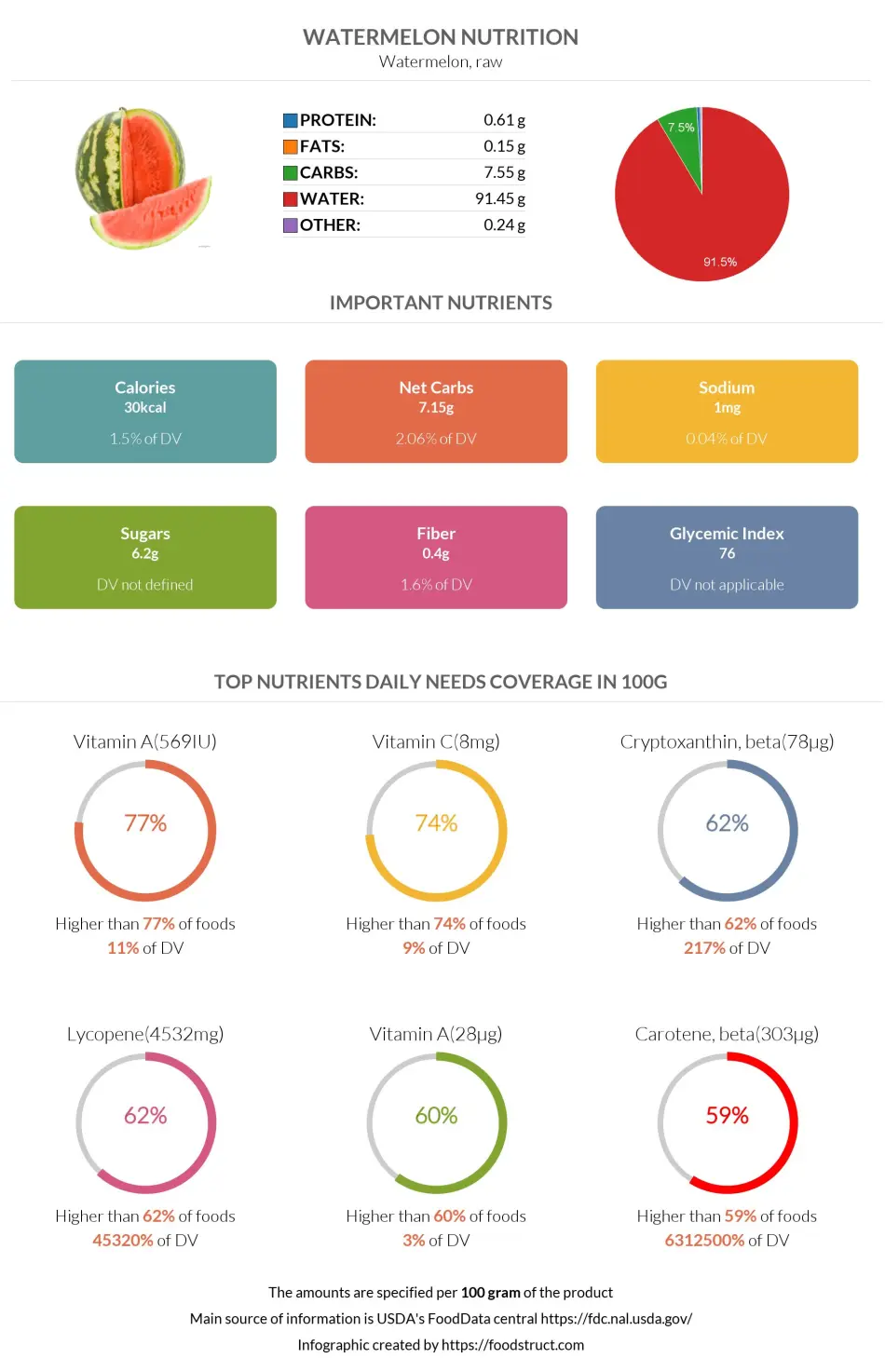
References
All the values for which the sources are not specified explicitly are taken from FDA’s Food Central. The exact link to the food presented on this page can be found below.

